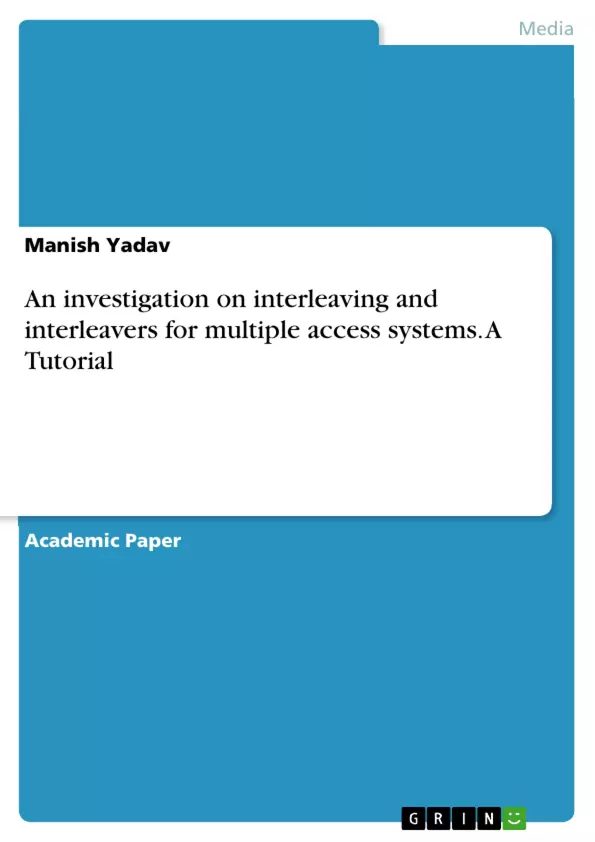In this tutorial, an investigation on interleaving and interleavers for the multiple access systems is presented
Multiple access techniques support multiple user scenarios in advanced cellular communication systems. Interleavers and interleaving schemes are used for user separation and data shuffling in these systems.
Modern day communication systems target to achieve errorless transmission of data between a transmitting and receiving end. An errorless transmission ensures high quality of service (QoS), reliability and security of data. Next generation communication system i.e., 5G aims to support voice/data/multi-media contents of high data rates with better quality and security.
The supporting 5G technologies like massive machine type communication (mMTC), enhanced mobile broadband (eMBB) and ultra-reliable low latency communication (URLLC) etc. also require higher reliability and availability of services with higher QoS. Therefore, error free transmission at higher data rates becomes a critical issue.
Forward error correcting (FEC) codes are deployed as an essential element of a digital communication system. Examples of the FEC codes are cyclic code, Bose-Chaudhuri-Hocquenghem (BCH) codes, linear block codes, convolution codes, turbo codes etc. These codes have potential to control those errors which occurs when digital information is passed through a communication channel. A channel may be a wireless or a wired channel. The FEC codes have the capability to detect and correct the errors present in the received data. However, only limited data bits in errors can be detected and corrected simultaneously by the FEC codes. This puts a certain limitation on efficiency
Inhaltsverzeichnis (Table of Contents)
- INTRODUCTION
- BURST ERRORS
- INTERLEAVING
- INTERLEAVERS AND THEIR ADVANTAGES
- MAJOR TYPES OF INTERLEAVERS
- RANDOM INTERLEAVERS
- CYCLIC INTERLEAVERS
- POWER INTERLEAVERS
- PRIME NUMBER INTERLEAVERS
- TREE INTERLEAVERS
- INVERSE TREE INTERLEAVERS
- MODERN FISHER-YATES INTERLEAVERS
- APPLICATIONS OF INTERLEAVERS
- INTERLEAVER CENTRIC SYSTEMS
- Conclusion
Zielsetzung und Themenschwerpunkte (Objectives and Key Themes)
This tutorial provides a comprehensive overview of interleaving and interleavers, their functionalities, and their role in multiple access systems. It examines the concept of burst errors, the challenges they pose, and how interleaving addresses these issues. The tutorial explores various types of interleavers and their advantages, including random, cyclic, power, prime number, tree, inverse tree, and modern Fisher-Yates interleavers.
- Understanding the concept of interleaving and its significance in communication systems
- Exploring the nature of burst errors and their impact on data transmission
- Analyzing different types of interleavers and their respective advantages
- Investigating the applications of interleavers in multiple access systems
- Examining the role of interleavers in enhancing data transmission reliability and efficiency
Zusammenfassung der Kapitel (Chapter Summaries)
- Introduction: This chapter sets the stage for the tutorial, highlighting the increasing demand for reliable and error-free data transmission in modern communication systems. The limitations of Forward Error Correcting (FEC) codes in handling burst errors are discussed, leading to the introduction of interleaving as a complementary error control mechanism.
- Burst Errors: This chapter provides a detailed explanation of burst errors, emphasizing their characteristics and the difficulties they present for traditional error correction methods. The concept of burst errors is illustrated through a figure showcasing the impact of these errors on a transmitted frame.
- Interleaving: This chapter delves into the principle of interleaving, explaining how it rearranges data bits to address burst errors. The chapter elaborates on the advantages of interleaving, including its ability to distribute burst errors across multiple code words, thereby improving error correction capabilities.
- Interleavers and Their Advantages: This chapter explores the different types of interleavers, discussing their unique features and benefits.
- Major Types of Interleavers: This chapter examines the various types of interleavers in detail, including random, cyclic, power, prime number, tree, inverse tree, and modern Fisher-Yates interleavers. Each section provides an in-depth analysis of the specific interleaver type, outlining its operation, advantages, and suitability for particular scenarios.
Schlüsselwörter (Keywords)
This tutorial focuses on interleaving and interleavers as critical components in multiple access systems. Key topics include burst errors, error correction, data shuffling, random interleavers, cyclic interleavers, power interleavers, prime number interleavers, tree interleavers, inverse tree interleavers, modern Fisher-Yates interleavers, and their applications in enhancing data transmission reliability and efficiency.
- Quote paper
- Manish Yadav (Author), 2020, An investigation on interleaving and interleavers for multiple access systems. A Tutorial, Munich, GRIN Verlag, https://www.grin.com/document/935040



